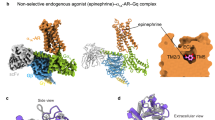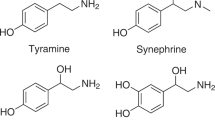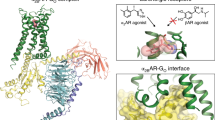Abstract
ADRENALINE- and noradrenaline-induced aggregation of human platelets1–3 is blocked by the α-adrenergic blocking agents, dihydroergotamine, phentolamine, phenoxybenzamine and dibenamine4–6, suggesting the involvement of α-adrenergic receptors. We have demonstrated that adrenaline and noradrenaline inhibit adenylate cyclase (EC 4.6.1.1) in lysates7 and particles8 of human platelets, an effect also blocked by such α-adrenergic antagonists. Synthetic phenylethylamine and imidazoline derivatives that act as α-adrenergic agonists in various other tissues neither induced primary platelet aggregation nor inhibited adenylate cyclase when added at concentrations up to 100 µM9. α-Adrenergic receptors have been identified in human platelets by binding studies using tritiated dihydroergocryptine10,11 or dihydroergonine12,13. The sites to which the dihydrogenated ergot alkaloids were bound showed the typical pattern of an α-adrenergic receptor with respect to displacement by adrenergic agonists and antagonists. However, there have been some discrepancies between the binding affinities of some α-adrenergic agonists and their biological efficacies concerning platelet aggregation and inhibition of adenylate cyclase. The α-adrenergic agonist, clonidine, displaced dihydroergocryptine from the binding sites with similar10 or even a 10-fold higher affinity11 relative to adrenaline, but clonidine (up to 100 µM) was ineffective in inducing primary platelet aggregation and inhibition of adenylate cyclase9. Similar dissociation constants were obtained for phenylephrine and noradrenaline in binding studies12, but in contrast to the natural compound, phenylephrine (up to 100 µM) was unable to induce a biological response9. We observed similar discrepancies with methoxamine, xylometazoline and oxymetazoline12,13. Agents that undergo the primary reaction of high affinity-binding to the receptor but are unable to induce secondary reactions in the form of biological responses should act as antagonists. We have tested this hypothesis and show here that various agents that are potent α-adrenergic agonists in various other systems are α-adrenergic antagonists in human platelets with respect to adrenaline-induced aggregation and inhibition of adenylate cyclase.
This is a preview of subscription content, access via your institution
Access options
Subscribe to this journal
Receive 51 print issues and online access
$199.00 per year
only $3.90 per issue
Buy this article
- Purchase on Springer Link
- Instant access to full article PDF
Prices may be subject to local taxes which are calculated during checkout
Similar content being viewed by others
References
Clayton, A. & Cross, M. J. J. Physiol., Lond. 169, 82P (1963).
O'Brien, J. R. Nature 200, 763–764 (1963).
Mitchell, J. R. A. & Sharp, A. A. Br. J. Haemat. 10, 78–93 (1964).
O'Brien, J. R. J. clin. Path. 17, 275–281 (1964).
Mills, D. C. B. & Roberts, G. C. K. J. Physiol., Lond. 193, 443–453 (1967).
Bygdeman, S. & Johnsen, O. Acta physiol. scand. 75, 129–138 (1969).
Jakobs, K. H., Saur, W. & Schultz, G. J. Cyclic Nucleotide Res. 2, 381–392 (1976).
Jakobs, K. H., Saur, W. & Schultz, G. FEBS Lett. 85, 167–170 (1978).
Jakobs, K. H., Saur, W. & Schultz, G. Naunyn-Schmiedebergs Arch. Pharmak. 302, 285–291 (1978).
Kafka, M. S., Tallman, J. F. & Smith, C. C. Life Sci. 21, 1429–1438 (1977).
Newman, K. D., Williams, L. T., Bishopric, N. H. & Lefkowitz, R. J. J. Clin. Invest. 61, 395–402 (1978).
Jakobs, K. H. & Rauschek, R. Naunyn-Schmiedebergs Arch. Pharmak. 302 (Suppl. R51 (1978).
Jakobs, K. H. & Rauschek, R. Klin. Wschr. (in the press).
Berthelsen, S. & Pettinger, W. A. Life Sci. 20, 595–606 (1977).
Born, G. V. R. Nature 194, 927–929 (1962).
Author information
Authors and Affiliations
Rights and permissions
About this article
Cite this article
JAKOBS, K. Synthetic α-adrenergic agonists are potent α-adrenergic blockers in human platelets. Nature 274, 819–820 (1978). https://doi.org/10.1038/274819a0
Received:
Accepted:
Issue Date:
DOI: https://doi.org/10.1038/274819a0
This article is cited by
-
Genetic control of adrenergic receptors on human platelets. A twin study
Human Genetics (1983)
-
3H-Rauwolscine binding in platelets from depressed patients and healthy volunteers
Psychopharmacology (1983)
-
?2-Adrenoceptors inhibit the cholera-toxin-induced intestinal fluid accumulation
Naunyn-Schmiedeberg's Archives of Pharmacology (1982)
-
Stimulation of prostaglandin E2-synthesis by noradrenaline in primary cell cultures from rabbit splenic pulpa is mediated by atypical ?-adrenoceptors
Naunyn-Schmiedeberg's Archives of Pharmacology (1981)
-
Novel α2-adrenoreceptors primarily responsible for inducing human platelet aggregation
Nature (1979)
Comments
By submitting a comment you agree to abide by our Terms and Community Guidelines. If you find something abusive or that does not comply with our terms or guidelines please flag it as inappropriate.



